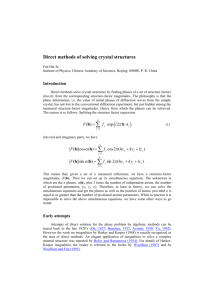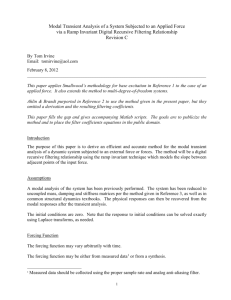Love Waves
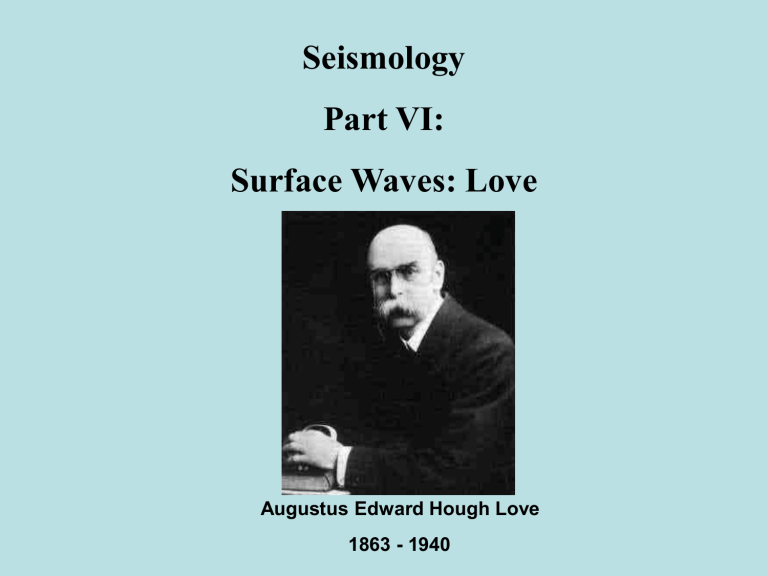
Seismology
Part VI:
Surface Waves: Love
Augustus Edward Hough Love
1863 - 1940
A Google result for “Love Wave”
Love Waves
Rayleigh waves propagate by interference of P and SV waves, but
SH waves do not interact with either.
However, they can propagate in a low wavespeed waveguide like the
Earth’s crust.
We consider a layer of thickness H and wavespeed with wavespeed
1
2 over a half space
, and
2
>
1 that there is a critical refraction).
(so
Because SH displacements satisfy the wave equation directly, we needn’t resort to potentials:
V
1
A exp( i ( px
1
1 x
3
t )) B exp( i ( px
1
1 x
3
t ))
V
2
C exp( i ( px
1
2 x
3
t ))
Where V
1 describes the up and down waves in the layer, and V the wave transmitted into the half space.
2 is
The boundary condition at the free surface is:
32
1
u
x
3
2
u
3
x
2
1
u
2
x
3
1
V
1
x
3
0 or
Ai
1 exp( i ( px
1
1 x
3
t )) Bi
1 exp( i ( px
1
1 x
3
t )) evaluated at x
3
= 0, this results in A = B.
At the bottom of the layer (x
3
= H), the same stress condition gives:
A
1
1
exp( i
1
H ) exp( i
1
H )
C
2
1 exp( i
2
H )
The continuity of displacement gives:
A
exp( i
1
H ) exp( i
1
H )
C exp( i
2
H ) exp( i ) exp( i ) cos( ) i sin( ) cos( ) i sin( ) 2 i sin( ) exp( i ) exp( i ) cos( ) i sin( ) cos( ) i sin( ) 2cos( )
so, taking the ratio of the above two boundary conditions gives: i
1
1 tan(
1
H )
2
2 or
tan(
1
H )
2
i
1
2
1
i
2
i
1
1
2
2
1
1
2
Note that if we are past the critical angle, then the argument on the right is real. Let’s rewrite the above using the definition of : tan
H 1/
1
2 1/ c 2
2
1
1/ c 2 1/
2
2
1/
1
2 1/ c 2
The above is a relationship between two variables: frequency and apparent horizontal wavespeed (c = 1/p). Solutions exist for > c
>
1
2
. We consider the solutions to the above equation graphically:
Here’s how to think about what’s going on in the top part of the figure:
Consider the argument to the tangent function on the left to be y(c).
Choose a frequency = 2 f and let c vary from its extremes of
1 and
2
. When c =
1
, y(c) = 0 and tan(0) = 0. The tangent repeats itself every time the argument increments by . Repeat the same choices of c for the right hand side of the equation, and it forms the dashed line decreasing from infinity to zero. Solutions to the equation are found where the lines intersect.
Note that there are a few discrete solutions to the equation. The one with the lowest value of c is called the fundamental mode, and the ones to the right are higher modes or overtones.
The number of overtones depends on the frequency: the higher the frequency, the more overtones. But because only a few discrete solutions exist, this happens discretely, not continuously. We can see from the above plot that a new overtone will be possible whenever c =
2 is a solution to the above equality. This happens when at the critical frequencies c satisfy: tan
c
H 1/
1
2 1/
2
2
0 or
c
for the m th overtone.
c
H 1/
1
2 1/
2
2 m
m
H 1/
1
2 1/
2
2
You might imagine all the tangents in the figure getting increasingly squished to the left as the frequency increases, with the value of c corresponding to a given overtone gradually decreasing from
2 to
1 as the frequency increases. This behavior is shown in the bottom plot.
The mode idea is easily explained in terms of constructive interference of plane waves traveling with a phase shift of 2 m (i.e. and integral multiple of 2 .
Suppose the angle of incidence is j, then the distance traveled from top to bottom (or bottom to top) is
X
H cos( j )
The distance from the wavefront to the reflection point is
A X cos(2 j ) X
2cos 2 ( j ) 1
Thus, the total distance is
2
X
H
X
cos(
2cos j )
2 ( j ) 1
2 H
1
1
2 X cos 2 ( j )
2 H cos 2 ( j )
2 H cos( j ) cos( j )
If is the wavelength, then the total change in phase just due to propagating this distance is:
d
4 H
1
1
4
c
H
1
sin( j )
1
2 H
1
c sin( j )
1 2 H
1 where c is the horizontal (apparent) wavelength, and /c = 2 / c
.
The total phase change is this amount plus the phase changes due to reflection – there is no phase shift at the free surface).
According to the expressions for R
SS
Wallace:
R
SS
1
1
1
1
i
i
2 in Table 3.1 of Lay and
2
2
2
e i
The denominator is the complex conjugate of the numerator, so
|Rss| = 1 and the phase angle is
n
2tan 1
1
2
1
2
2tan 1
2
1
1
2
(NB: think of how complex conjugates look in the complex plane – the angles above and below the real axis are equal and opposite, which is the reason for the factor of “2” out front). The total phase change is thus
d
n
2 H
1
2tan 1
1
2
1
2
Constructive interference will occur whenever the above sum is a multiple of 2 . For the fundamental mode, we take the phase shift to be zero, in which case:
2 H
1
2tan 1
2
1
1
2 or
tan
H
1
2
1
1
2 which is the equation derived above. The higher orders correspond to integral multiples of 2 .
Notes:
1.
Because Love waves are all SH, they show up on the transverse components of a seismogram (not radial or vertical).
2. Love waves travel at the shear waves speed of the upper mantle, which means they travel faster than
Rayleigh waves and thus arrive sooner.
3. Love waves are naturally dispersive, with longer wavelengths
(lower frequencies) traveling faster.
Seismogram recored by a three-component long-period system (BNY) at the State
Univ. of New York, Binghamton approximately 380 km from an earthquake. Note that the Rayleigh-type surface waves appear on the Z and East components, while the Love-type surface waves appear on the North component (back azimuth is 260 deg.)

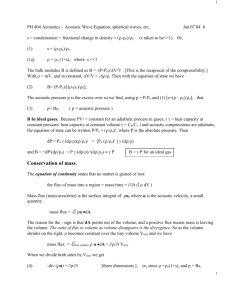




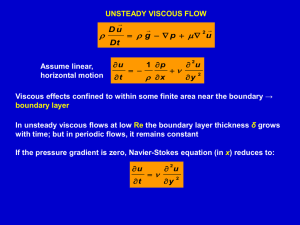




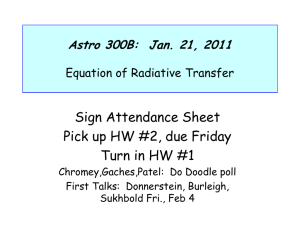
![OpticsI15FourierTransformII[1]](http://s2.studylib.net/store/data/005720229_1-f75e74d4786e37301f729f36f308c422-300x300.png)
